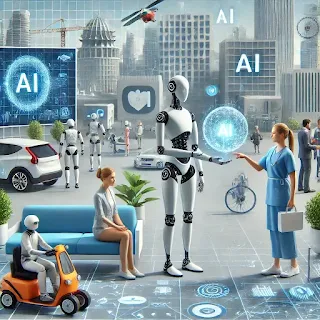The Evolution of Artificial Intelligence: From Concept to Reality
- Get link
- X
- Other Apps
The Evolution of Artificial Intelligence: From Concept to Reality
Introduction
Artificial Intelligence (AI) refers to the simulation of human intelligence in machines, enabling them to perform tasks that typically require human cognition. These tasks include problem-solving, learning, language understanding, and decision-making. AI has rapidly evolved over the decades, influencing various industries, from healthcare to finance. In this article, we will explore the history, milestones, and future prospects of AI.
 |
| A visually engaging historical timeline of artificial intelligence, highlighting key milestones such as the Turing Test, Dartmouth Conference, expert systems, and deep learning |
The History of Artificial Intelligence
The Foundations (1950s - 1970s)
The concept of AI dates back to the mid-20th century. In 1950, mathematician and computer scientist Alan Turing introduced the idea of machine intelligence in his paper Computing Machinery and Intelligence. He proposed the Turing Test, a method to assess whether a machine can exhibit intelligent behavior indistinguishable from a human.
In 1956, the term Artificial Intelligence was officially coined at the Dartmouth Conference, marking the beginning of AI as a research field. Early AI programs were capable of solving algebra problems, proving theorems, and engaging in simple conversations. However, due to limited computing power and data availability, progress slowed down in the following decades.
The AI Winter and Revival (1980s - 1990s)
After initial excitement, AI research faced setbacks known as AI Winters—periods of reduced funding and interest due to unmet expectations. However, in the 1980s, expert systems—programs designed to mimic human decision-making in specific fields—revived AI interest. These systems found applications in medicine, engineering, and business.
By the 1990s, advancements in computing power and algorithms reignited AI development. In 1997, IBM’s Deep Blue defeated world chess champion Garry Kasparov, demonstrating AI’s ability to outperform humans in specialized tasks.
 |
| A modern and visually appealing depiction of AI-powered robots assisting humans in healthcare, transportation, and smart home automation, illustrating AI’s seamless integration into |
AI in the 21st Century
With the rise of big data, faster processors, and improved algorithms, AI has become a crucial part of modern life. Today, AI applications include:
- Personal Assistants: Virtual assistants like Siri, Alexa, and Google Assistant use AI for speech recognition and natural language processing.
- Healthcare: AI-powered diagnostic tools help doctors detect diseases such as cancer at early stages.
- Autonomous Vehicles: Self-driving cars rely on AI to interpret sensor data and make driving decisions.
- Finance: AI algorithms analyze financial markets, predict trends, and automate trading.
- Entertainment: AI powers recommendation engines on platforms like Netflix and Spotify.
The Future of AI
The future of AI is both exciting and challenging. As deep learning and neural networks advance, AI is expected to revolutionize industries further. However, concerns regarding ethics, job displacement, and privacy remain critical. Ensuring responsible AI development will be essential to maximizing its benefits while mitigating risks.
 |
|
Conclusion
From a theoretical concept to an essential part of our daily lives, AI has come a long way. With continuous innovations, AI’s impact will only grow, shaping the future of technology and society. As we move forward, ethical considerations and responsible AI development will play a crucial role in ensuring a balanced integration of artificial intelligence into our world.
References
- Get link
- X
- Other Apps




Comments
Post a Comment